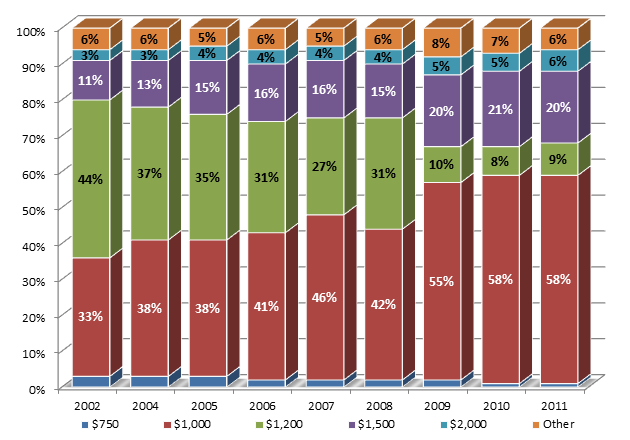The traditional one-sentence explanation of annual-maximum trends in dental insurance over the last decade has been, “The $1,000 annual maximum has become the standard” – and it has. But what’s happening outside of the $1,000 annual max is perhaps even more interesting.
Consider this graph of annual maximums in Delta Dental’s book of business over the last decade:
The $1,000 annual max has become far more popular, increasing in frequency from one-third of Delta Dental’s book to almost 60 percent of the book, almost entirely at the expense of the $1,200 annual maximum. But consider this: Over the same period the $1,500 annual max has nearly doubled in popularity, and the $2,000 annual max has doubled in popularity.
Some reasons why are fairly obvious. Dental costs have increased approximately 20 percent since 2002. An aging workforce requires more expensive dental treatments. And a higher dental annual maximum can help offset cutbacks in healthcare coverage.
However, some of these pat explanations may not really explain what’s going on. The frequency of expensive treatments like root canals and crowns has actually fallen over the last 10 years, from 21.1 percent to 17.3 percent. The real increase in utilization has come from increased consumption of preventive services like cleanings, the result of more dentists putting more patients (with dental insurance) on a regular treatment regimen.
The actual reasons behind the shift to higher annual maximums are more complex, and deal with the interaction between dental care and overall healthcare. For consumers, the money to pay dental bills and doctor bills comes out of the same pot. Very often it’s in an HSA or flex account. A higher annual maximum in dental means that less money has to come out of that healthcare pot to pay for a crown, a root canal or an implant – and the tradeoff in cost is reasonable.
With more employees paying a greater percentage of their premium, this sort of tradeoff should only increase in frequency.
The $1,000 annual maximum isn’t going anywhere. It is the standard, and will remain the standard. But higher annual maximums are here to stay as well.


